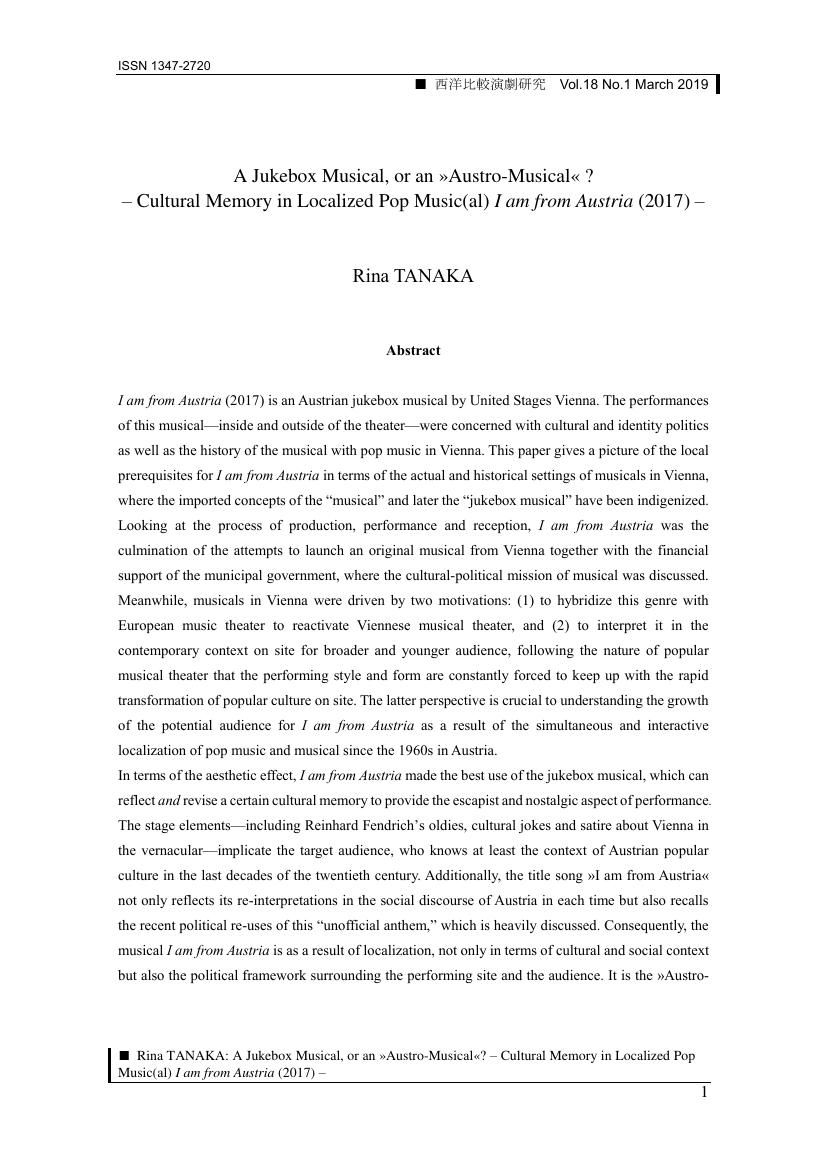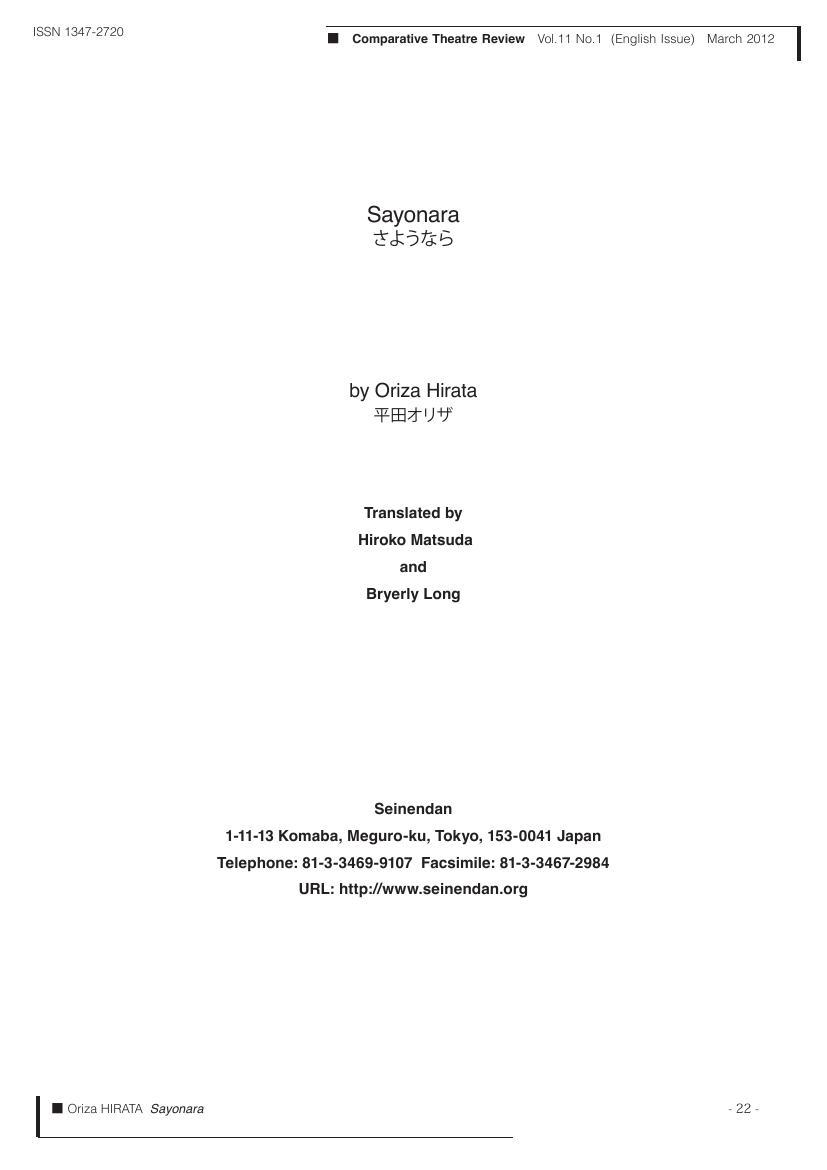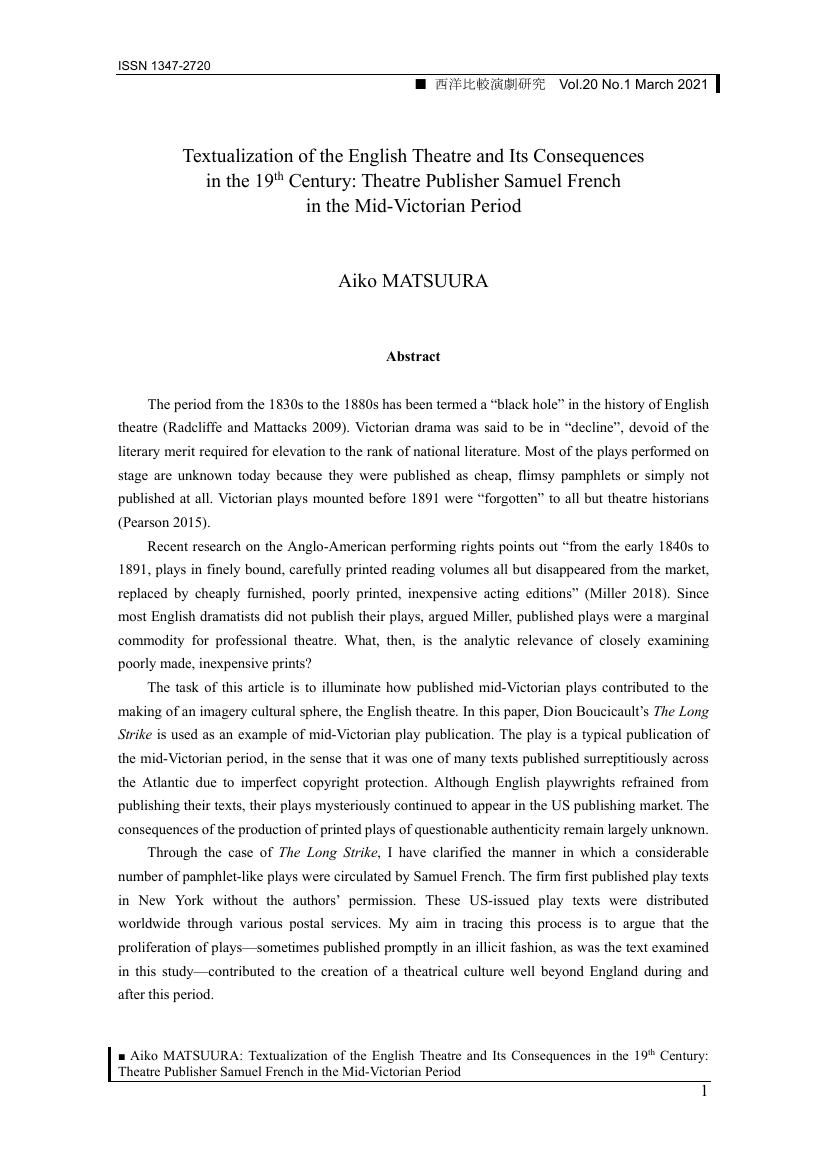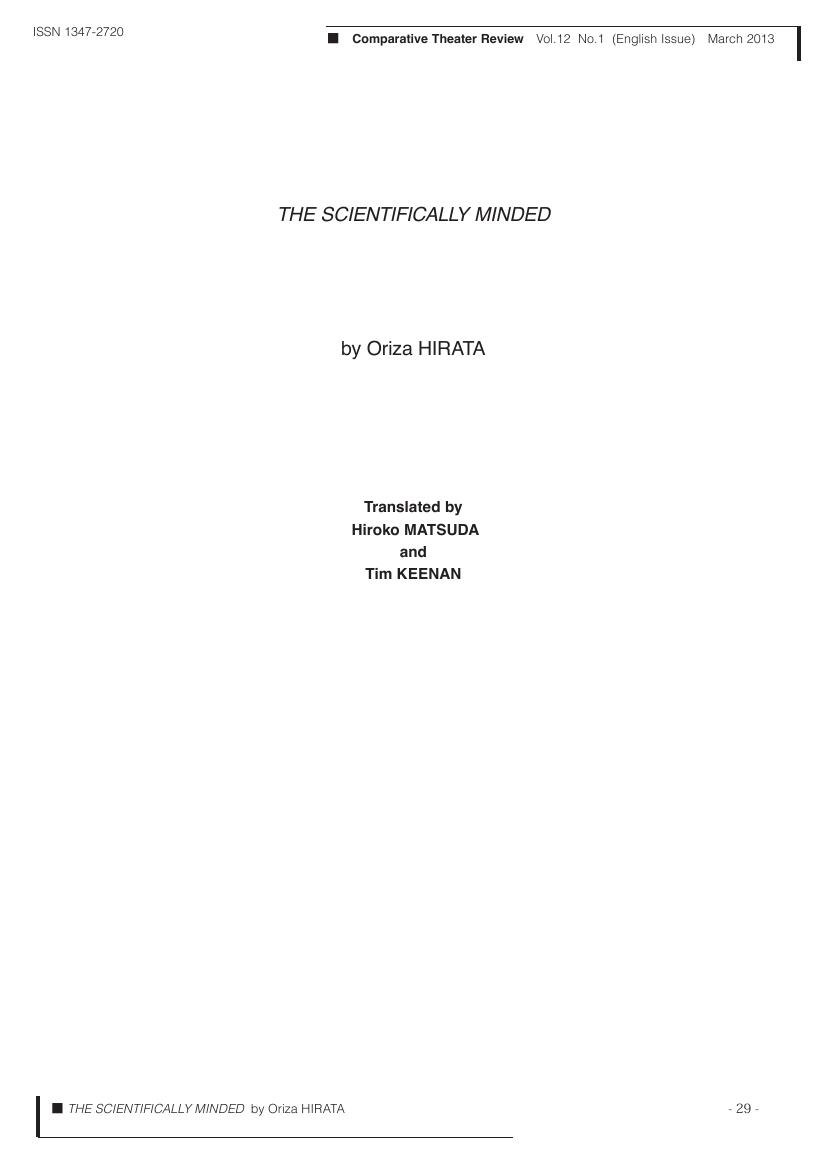- 著者
- 田中 里奈
- 出版者
- Japanese Society for Theatre Research. Comparative Theatre Section
- 雑誌
- 西洋比較演劇研究 (ISSN:13472720)
- 巻号頁・発行日
- vol.18, no.1, pp.1-20, 2019 (Released:2019-04-01)
3 0 0 0 OA Oscillating Between Fakery and Authenticity
- 著者
- Kei HIBINO
- 出版者
- Japanese Society for Theatre Research. Comparative Theatre Section
- 雑誌
- 西洋比較演劇研究 (ISSN:13472720)
- 巻号頁・発行日
- vol.11, no.1, pp.30-42, 2011 (Released:2012-03-15)
- 参考文献数
- 3
- 被引用文献数
- 1 6 2
This paper will propose to evaluate Good-bye (Sayonara), the “first android theatre piece” which premiered in 2010. Rather than focus on technological advances, however, I will focus on the piece as artwork that reflects the aesthetics of Hirata Oriza (1962-), a Japanese playwright and director who produced this work in collaboration with roboticist Ishiguro Hiroshi. While some denounce Good-bye as being no better than mechanical puppetry, it encapsulates Hirata's dramaturgical principle of oscillating between fakery and authenticity, which has characterized his plays since he began his professional career in the mid-1980s. One of his representative works, Citizens of Seoul (1989) and its sequels serve my purpose of demonstrating this characteristic. Featuring a dying young woman and her android attendant, Good-bye appears to be a cheap melodrama that provokes sentimentalism, but it maintains its precarious poise by regaining authenticity through the playwright's tactful device of having the android recite poems. The thematic tension between similarities and difference in the poems recapitulates Hirata's dramaturgical focus on the juxtaposition of genuineness with falsity.
1 0 0 0 OA 七代目松本幸四郎の「変相」研究とその周辺
- 著者
- 村島 彩加
- 出版者
- Japanese Society for Theatre Research. Comparative Theatre Section
- 雑誌
- 西洋比較演劇研究 (ISSN:13472720)
- 巻号頁・発行日
- vol.11, no.2, pp.80-93, 2011 (Released:2012-03-16)
- 参考文献数
- 38
Matsumoto Kôshirô VII (1870-1949) is now remembered for his authentic rendition of kabuki classics. However, in his youth, he was interested in Western culture and learned English, Western dance and the violin. Worthy of special mention is his experiments with Western make-up, which he learned from Making Up (Witmark & Sons 1905), a stage make-up manual by American actor James Young.Kôshirô had photographs of his wearing Western make-up taken and published themin Japanese theater magazine Engei Gahô serially, under the title of “hensô”. Literally meaning “to change one's looks,” “hensô” can imply more than changing one's appearance by putting on make-up. I would argue that Matsumoto's engrossment in Western make-up prefigured the subsequent development of interest in facial expressions as an acting technique, which was advocated by theatre theorists and practitioners who had seen or studied Western theater in early twentieth century Japan. The irony with this is that, while those who emphasized the importance of “hyôjyô” - a rarely used word then meaning facial expressions - and sought guidance for Kôshirô's “hensô” series pursued a new style of acting to get rid of old kabuki, Kôshirô studied Western make-up for his acting in kabuki theater.Kôshirô's photos have not been fully appreciated because his experiments with Western make-up were considered an amateurish hobby. However, considering the influences his study had on shingeki actors - he taught Western make-up methods at Tokyo Haiyu Yôseijo, a training facility for shingeki actors - it is necessary to cast a new light on Kôshirô, who is usually understood as a superb Meiji-era kabuki actor endowed with a beautiful body suitable for kabuki classics. Certainly, he was a pioneer in modernizing kabuki acting as well as a mediator between kabuki and modern Japanese theater.
1 0 0 0 OA Sayonara
- 著者
- Oriza HIRATA
- 出版者
- Japanese Society for Theatre Research. Comparative Theatre Section
- 雑誌
- 西洋比較演劇研究 (ISSN:13472720)
- 巻号頁・発行日
- vol.11, no.1, pp.22-28, 2011 (Released:2012-03-15)
- 被引用文献数
- 3 3
1 0 0 0 OA 活動記録
- 出版者
- Japanese Society for Theatre Research. Comparative Theatre Section
- 雑誌
- 西洋比較演劇研究 (ISSN:13472720)
- 巻号頁・発行日
- vol.11, no.2, pp.126-142, 2011 (Released:2012-03-16)
- 著者
- 松浦 愛子
- 出版者
- Japanese Society for Theatre Research. Comparative Theatre Section
- 雑誌
- 西洋比較演劇研究 (ISSN:13472720)
- 巻号頁・発行日
- vol.20, no.1, pp.1-27, 2021 (Released:2021-03-31)
1 0 0 0 OA Scientifically Minded
- 著者
- Oriza HIRATA Hiroko MATSUDA Tim KEENAN
- 出版者
- Japanese Society for Theatre Research. Comparative Theatre Section
- 雑誌
- 西洋比較演劇研究 (ISSN:13472720)
- 巻号頁・発行日
- vol.12, no.1, pp.29-118, 2013-03-15 (Released:2013-03-15)
- 著者
- 村島 彩加
- 出版者
- Japanese Society for Theatre Research. Comparative Theatre Section
- 雑誌
- 西洋比較演劇研究 (ISSN:13472720)
- 巻号頁・発行日
- vol.11, no.2, pp.80-93, 2011
Matsumoto Kôshirô VII (1870-1949) is now remembered for his authentic rendition of kabuki classics. However, in his youth, he was interested in Western culture and learned English, Western dance and the violin. Worthy of special mention is his experiments with Western make-up, which he learned from <i>Making Up</i> (Witmark & Sons 1905), a stage make-up manual by American actor James Young.<br>Kôshirô had photographs of his wearing Western make-up taken and published themin Japanese theater magazine <i>Engei Gahô</i> serially, under the title of "hensô". Literally meaning "to change one's looks," "hensô" can imply more than changing one's appearance by putting on make-up. I would argue that Matsumoto's engrossment in Western make-up prefigured the subsequent development of interest in facial expressions as an acting technique, which was advocated by theatre theorists and practitioners who had seen or studied Western theater in early twentieth century Japan. The irony with this is that, while those who emphasized the importance of "hyôjyô" - a rarely used word then meaning facial expressions - and sought guidance for Kôshirô's "hensô" series pursued a new style of acting to get rid of old kabuki, Kôshirô studied Western make-up for his acting in kabuki theater.<br>Kôshirô's photos have not been fully appreciated because his experiments with Western make-up were considered an amateurish hobby. However, considering the influences his study had on shingeki actors - he taught Western make-up methods at Tokyo Haiyu Yôseijo, a training facility for shingeki actors - it is necessary to cast a new light on Kôshirô, who is usually understood as a superb Meiji-era kabuki actor endowed with a beautiful body suitable for kabuki classics. Certainly, he was a pioneer in modernizing kabuki acting as well as a mediator between kabuki and modern Japanese theater.




